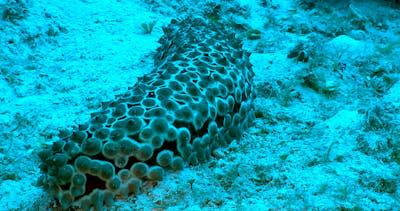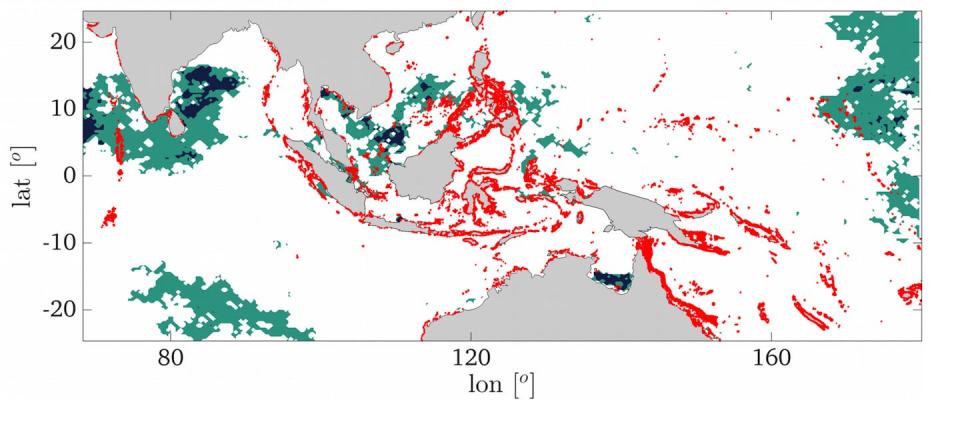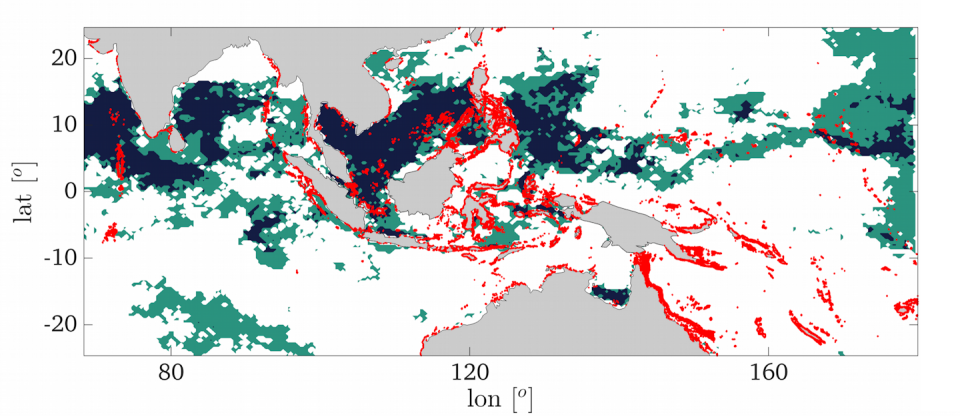
My Georgia Tech colleague Mark Hay recently published a study which showed that removing sea cucumbers from reef communities led to an increase in organic waste materials and a 15-fold rise in coral deaths. Protecting sea cucumbers, which are overharvested as a food source, could help keep coral reefs healthy.
The role of ocean connectivity
Coral reefs are not isolated outposts. When fish and corals spawn, they release millions of larvae that drift on currents and are exchanged across reefs through mixing and transport processes. These exchanges make up the connectivity of coral reefs.
Some reefs supply larvae to many others. Other reefs are more isolated, so scientists may need to artificially introduce larvae to help the reefs recover from bleaching and other threats.
Research shows that well-connected reefs recover faster from stresses like bleaching. Receiving plentiful supplies of coral and fish larvae, transported by ocean currents from far away, helps to restore bleached areas and maintain diverse reef communities. Preserving this connectivity is key for reef conservation.
But measuring connectivity is time-consuming and expensive. Researchers collect coral samples from reefs that may be connected and analyze the corals’ DNA to reconstruct their genetic history. This yields a picture of how interrelated different populations are.
We also use computer models to simulate ocean currents carrying virtual larvae from their release points to the locations where they settle. But currents aren’t fixed in place like highways: Their strength and direction change over time, depending on the season and the year. Studying reef connectivity requires carrying out multiyear model simulations covering small areas in fine detail, which involves a lot of computation.


Insights from machine learning
Now, machine learning offers a new way to analyze reef connections. This subfield of artificial intelligence enables computers to learn tasks or associations without explicitly being directed. Instead, they use algorithms to tackle various tasks.
My research group has developed a tool that takes information about ocean currents, derived from satellite data; generates a network of ecoregions, or areas where ecosystems are generally similar; and calculates their connectivity over the past 30 to 40 years. We then identify better-connected reefs using PageRank centrality – the algorithm that Google developed to measure the popularity of web pages.
Once we have defined a network of ecoregions, it is possible to determine how “popular” – that is, connected – known reefs are. And we can verify that our algorithms are working well by seeing whether “popular” reef communities contain more diverse and healthy coral populations.
We have found that in Southeast Asia’s Coral Triangle – the biggest biodiversity hot spot on Earth – periodic shifts between the El Niño and La Niña climate patterns promote biodiversity, and likely have done so for the past 5 million to 7 million years. Connectivity during El Niño events is very different from that during La Niñas, because ocean currents are different. This dynamic aids reefs by ensuring that they receive larvae from many different places in different years.
Understanding which coral and environmental traits helps make reefs resilient, and coupling this information with connectivity networks opens new avenues for helping corals to survive a bit longer. Together, these approaches indicate how and where to prioritize monitoring and restoration efforts.
In the long run, the only ways to stop coral die-offs and protect reef habitats that support so much sea life are limiting water pollution and curbing climate change. But more localized actions that make reefs healthier can buy them some time, and perhaps make them more resilient to ocean warming.
This article is republished from The Conversation, a nonprofit, independent news organization bringing you facts and analysis to help you make sense of our complex world.
It was written by: Annalisa Bracco, Georgia Institute of Technology.
Read more:
Annalisa Bracco benefitted from funding from the National Science Foundation and from the National Oceanic and Atmospheric Administration for this work.
